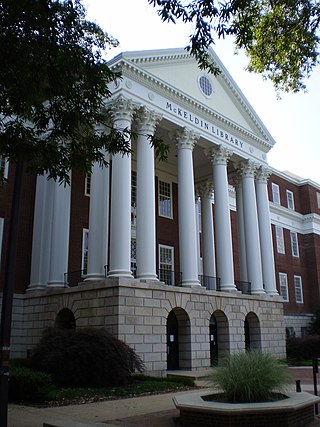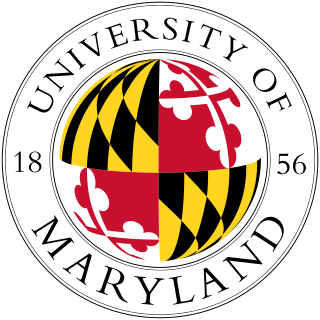Related Research Articles

The Université du Québec à Montréal(UQAM; English:University of Quebec in Montreal;French pronunciation: [ynivɛʁsite dy kebɛk a mɔ̃ʁeal]), is a French-language public research university based in Montreal, Quebec, Canada. It is the largest constituent element of the Université du Québec system.

The George Washington University is a private federally chartered research university in Washington, D.C. Chartered in 1821 by the United States Congress, GW is the largest institution of higher education and the only member of the Association of American Universities in Washington, D.C.

St. Mary's College of Maryland (SMCM) is a public liberal arts college in St. Mary's City, Maryland. Established in 1840, St. Mary's College is an honors college that claims to "offer an experience similar to that of an elite liberal arts college". With about 1,600 enrolled students, the institution offers bachelor's degrees in 21 disciplines, as well as a master's program and certification programs.

Towson University is a public university in Towson, Maryland. Founded in 1866 as Maryland's first training school for teachers, Towson University is a part of the University System of Maryland. Since its founding, the university has evolved into eight subsidiary colleges with over 20,000 students. Its 329-acre campus is situated in Baltimore County, Maryland eight miles north of downtown Baltimore. Towson is one of the largest public universities in Maryland and still produces the most teachers of any university in the state.

Mary Ellen Miller is an American art historian and academician specializing in Mesoamerica and the Maya.

The University of Maryland Libraries is the largest university library in the Washington, D.C. – Baltimore area. The university's library system includes eight libraries: six are located on the College Park campus, while the Severn Library, an off-site storage facility, is located just outside campus, and the Priddy Library is located on the University System of Maryland satellite campus in Shady Grove.
Stephen Douglas Houston is an American anthropologist, archaeologist, epigrapher, and Mayanist scholar, who is particularly renowned for his research into the pre-Columbian Maya civilization of Mesoamerica. He is the author of a number of papers and books concerning topics such as the Maya script, the history, kingships and dynastic politics of the pre-Columbian Maya, and archaeological reports on several Maya archaeological sites, particularly Dos Pilas and El Zotz. In 2021, National Geographic noted that he participated in the correct cultural association assigned to a half-size replica discovered at the Tikal site of the six-story pyramid of the mighty Teotihuacan culture, which replicated its Citadel that includes the original Feathered Serpent Pyramid.

Karl Andreas Taube is an American Mesoamericanist, Mayanist, iconographer and ethnohistorian, known for his publications and research into the pre-Columbian cultures of Mesoamerica and the American Southwest. As of 2009 he holds a position as Professor of Anthropology at the College of Humanities, Arts, and Social Sciences, University of California, Riverside. In 2008 he was named the College of Humanities, Arts, and Social Sciences distinguished lecturer.

Merle Greene Robertson was an American artist, art historian, archaeologist, lecturer and Mayanist researcher, renowned for her extensive work towards the investigation and preservation of the art, iconography, and writing of the pre-Columbian Maya civilization of Central America. She is most famous for her rubbings of Maya carved stelae, sculpture, and carved stone, particularly at the Maya sites of Tikal and Palenque.
The Zanvyl Krieger School of Arts & Sciences is an academic division of the Johns Hopkins University, a private research university in Baltimore, Maryland. The school is located on the university's Homewood campus. It is the core of Johns Hopkins, offering comprehensive undergraduate education and graduate training in the humanities, natural sciences, and social sciences.
Elizabeth Hill Boone is an American art historian, ethnohistorian and academic, specialising in the study of Latin American art and in particular the early colonial and pre-Columbian art, iconography and pictorial codices associated with the Mixtec, Aztec and other Mesoamerican cultures in the central Mexican region. Her extensive published research covers investigations into the nature of Aztec writing, the symbolism and structure of Aztec art and iconography and the interpretation of Mixtec and Aztec codices.
Robert J. Sharer was an American archaeologist, academic and Mayanist researcher. He was known for his archaeological investigations at a number of pre-Columbian Mesoamerican sites conducted over a career spanning four decades, and for his archaeological reports, theorizing, and writings in his field of specialty, the ancient Maya civilization. Sharer was a lecturer and professor at the University of Pennsylvania's Department of Anthropology for more than 30 years, and as of 2008 occupied the endowed chair of Sally and Alvin V. Shoemaker Professor in Anthropology, an appointment which he held beginning in 1995. He also had an extensive association with Penn's University Museum of archaeology and anthropology, where from 1987 to 2009 he was the curator-in-charge of the Museum's American collection and research section. He died on September 20, 2012.
Richard A. Diehl is an American archaeologist, anthropologist and academic, noted as a scholar of pre-Columbian Mesoamerican cultures. He is particularly renowned for his extensive contributions in the study of the Olmec civilization, which flourished in the Gulf Coast of Mexico region during the Formative period in Mesoamerican chronology and widely influenced subsequent Mesoamerican cultures. Diehl retired from formal academia at the end of the 2007 academic year, after a career spanning over four decades. He retained title as Professor Emeritus in the Department of Anthropology at the University of Alabama (UA), Tuscaloosa. Post-retirement Diehl continues to be active in Mesoamerican and archaeological research, teaching classes and authoring publications on the Olmec and other archaeological subjects.

Simon Martin is a British epigrapher, historian, writer and Mayanist scholar. He is best known for his contributions to the study and decipherment of the Maya script, the writing system used by the pre-Columbian Maya civilisation of Mesoamerica. As one of the leading epigraphers active in contemporary Mayanist research, Martin has specialised in the study of the political interactions and dynastic histories of Classic-era Maya polities. Since 2003 Martin has held positions at the University of Pennsylvania Museum of Archaeology and Anthropology where he is currently an Associate Curator and Keeper in the American Section, while teaching select courses as an Adjunct Associate Professor in the Department of Anthropology at the University of Pennsylvania.
Vernon Lee Scarborough is an American academic anthropologist and archaeologist, known for his research and publications on settlement, land use and water management practices of archaic and Pre-industrial society.
Susan D. Gillespie is an American academic anthropologist and archaeologist, noted for her contributions to archaeological and ethnohistorical research on pre-Columbian Mesoamerican cultures, in particular the Aztec, Maya and Olmec. As of 2009 Gillespie holds a position as professor in the Department of Anthropology at University of Florida, Gainesville, USA, having also been associate chair of the department from 2003 until 2009.
Mark Paul Leone is an American archaeologist and professor of anthropology at the University of Maryland, College Park. He is interested in critical theory as it applies to archaeology and, particularly, to historical archaeology. He has directed Archaeology in Annapolis since 1981. This project focuses on the historical archaeology of Annapolis and Maryland's Eastern Shore and features the use of critical theory. Leone is committed to public interpretation and teaches his students about the relationship between public interpretation and the politics of archaeology.
Esther Pasztory is a professor emerita of Pre-Columbian art history at Columbia University. From 1997 to her retirement in 2013 she held the Lisa and Bernard Selz Chair in Art History and Archaeology. Among her many publications are the first art historical manuscripts on Teotihuacan and the Aztecs. She has been the recipient of a Guggenheim Fellowship (1987–88) and a senior fellow of the board of Dumbarton Oaks.

Leonardo Náuhmitl López Luján is an archaeologist and one of the leading researchers of pre-Hispanic Central Mexican societies and the history of archaeology in Mexico. He is director of the Templo Mayor Project in Mexico's National Institute of Anthropology and History (INAH) since 1991 and son of renowned historian Alfredo López Austin. He is fellow of El Colegio Nacional, the British Academy, the Society of Antiquaries of London, the Real Academia de la Historia in Madrid, the American Academy of Arts & Sciences, and the Académie des Inscriptions et Belles-Lettres in Paris.
References
- Department of Art History & Archaeology (Spring 2005). "Hail & Farewell" (PDF online publication). Art History & Archaeology Newsletter. College Park: University of Maryland. 6: 13. Retrieved 2009-03-15.
- University of Maryland Graduate School (2006). "Distinguished Faculty". Graduate Catalog Fall 2006. University of Maryland. Archived from the original on 2009-06-24. Retrieved 2009-03-15.